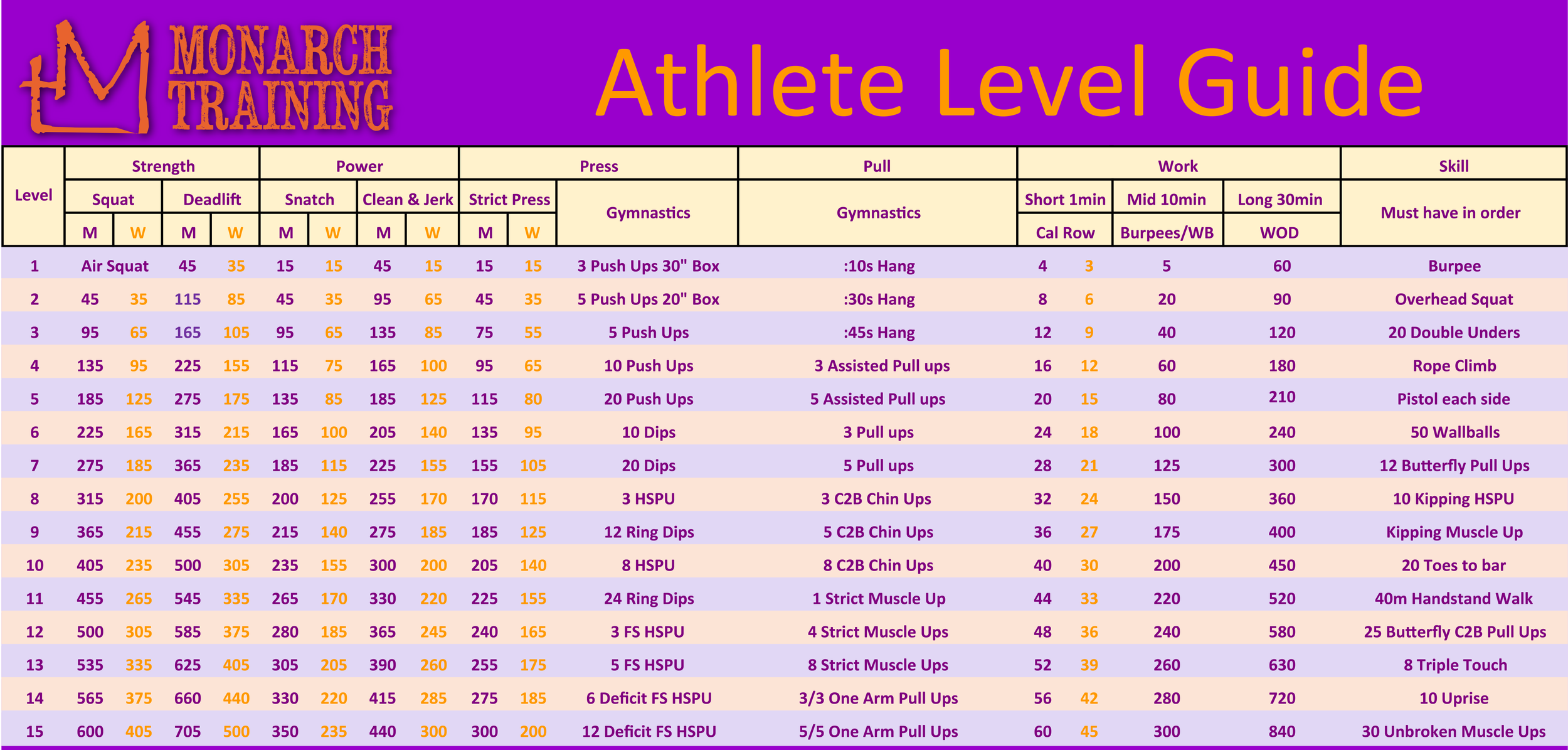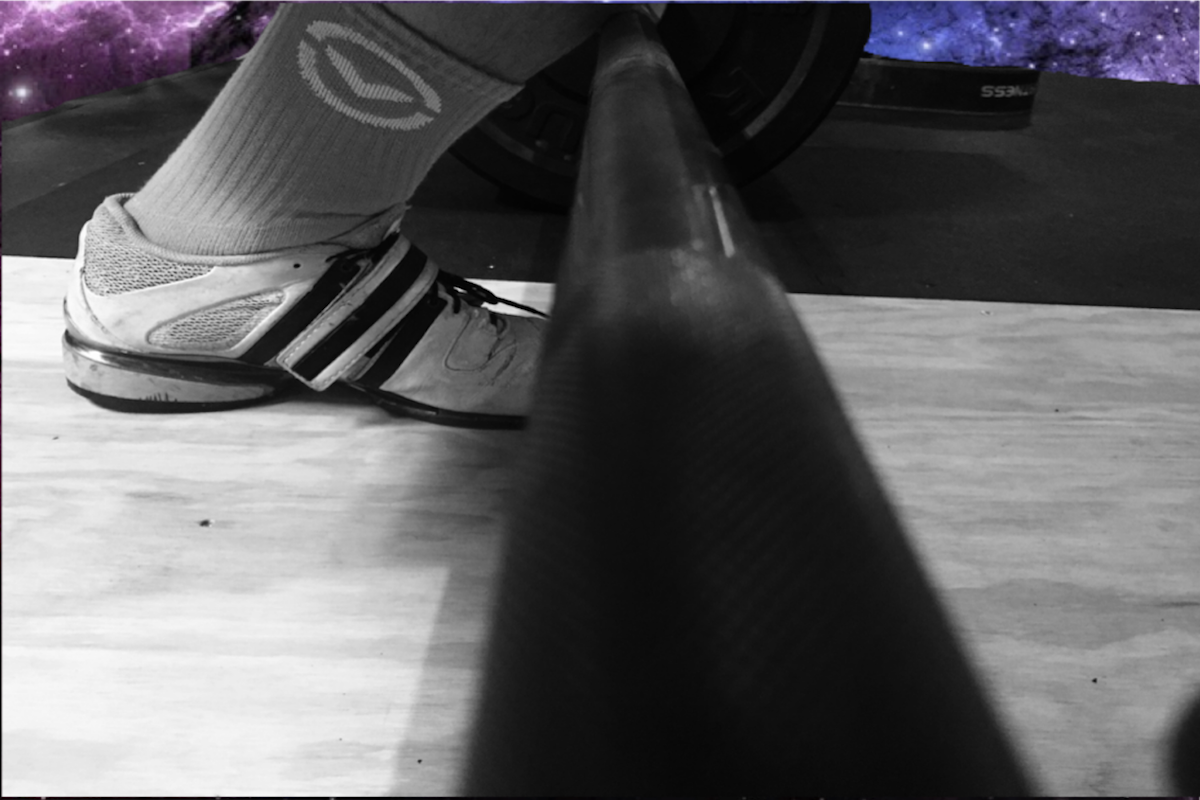Monarch Training Athlete Level Guide
The Monarch Training Athlete Level Guide has been built to help define the route to improvement as a CrossFitter. Many of the standard goals out there aren’t true indicators of your performance in CrossFit. Example: many places say a double bodyweight back squat is a good goal. That doesn’t work for a few reasons. First, strength doesn't scale based on body weight. Second, in CrossFit, a workout like Fran is pull ups and thrusters at 95 pounds, not at half body weight. That is, there are standard weights not standard ratios. An example that makes this very clear would be the WOD "Diane" 21-15-9 of deadlifts at 225 and handstand push-ups. Using the standard of body weight ratio; let’s say we have two athletes competing against each other. Athlete 1 weighs 100lbs and deadlifts 250 lbs, or 2.5 times his body weight. Athlete 2 weighs 200lbs and deadlifts 300 lbs, or 1.5 times his body weight. Based on body weight ratio, Athlete 1 is far stronger than Athlete 2, but in doing Diane there is no way Athlete 1 will beat Athlete 2 having to perform 45 total deadlifts at 90% of his 1RM while Athlete 2 is lifting 75%. For this reason the Monarch Training CrossFit Level Guide was created.
The Monarch Training CrossFit Level Guide
There are six different categories each with 15 levels. Strength, Power, Press, Pull, Work, and Skill. Most of these categories have subcategories to better assess an athlete’s ability level.
Strength
In strength there are two tests: 1RM back squat and 1RM Deadlift. An athlete is the highest level their 1RM is equal to or greater than. For the overall strength score level, average the two together. When looking to improve the strength score, focus on the weakness first, the lower of the two.
Power
In power there are two tests: 1RM Snatch and 1RM Clean and Jerk. An athlete is the highest level their 1RM is equal to or greater than. For the overall power score level, average the two together. When looking to improve the power score, focus on the weakness first, the lower of the two.
Press
In Press there are two tests: 1RM strict press and unbroken strict gymnastic pressing movements. An athlete is the highest level their 1RM is equal to or greater than. For the overall strength score level, average the two together. When looking to improve the press score, focus on the weakness first, the lower of the two. Specifics: FS=Free Standing, HSPU=Handstand Push Ups, the dips in levels 6 and 7 are on a stationary set of handles or between boxes where the athlete is completely off the ground, the handstand push ups in levels 14 and 15 are to a deficit of 9".
Pull
In Pull there is one test of unbroken strict gymnastic pulling movements. An athlete is the highest level they can perform. Specifics: C2B=Chest to Bar, the assisted pull ups in levels 4 and 5 are to be done with a band equivalent to the green Rogue Monster Band (41"x1.13"x.18, 65lb resistance)
Work
In work there are three different tests to find an athlete’s work capacity over three different time domains. Test one is short, 1min max calorie Row. Test two is for mid-range duration, 10 minutes of alternating between Even: max burpees, Odd: max Wallballs (guys: 20lbs to 10'/ girls: 14lbs to 9') score is total reps. Test three is a test of endurance, The Monarch Endurance WOD: 30min AMRAP 50 calorie row 40 burpees 30 Russian kettlebell swings at 24kgs for men and 16kgs for women.
Skill
For skill there are 15 different levels just like the other tests, but an athlete must be able to perform all lower levels of skill before scoring at a higher level. The athlete’s score is one level below the first skill they can not do. Specifics: For the Over Head Squat the athlete must be able to meet the standard depth of a squat while keeping their arms locked out overhead throughout the entire movement with an empty bar (45lbs for men, 35lbs for women. In the rope climb the athlete must reach a mark of 15 ft with one of their hands.
How to Use the Guide
The Monarch Level Guide will help you identify the weaknesses in your game. Since the sport requires a well-rounded athlete, you will need to work on your weakness first. In a WOD it doesn’t matter how great you are at something if you take too long or can’t get to it because there is a weak movement for you before it. This imbalance will not only cause poor performances in WODs but can lead to injury. Once you have your score you’ll need to adjust your program to address weaknesses. The first concern should be the lowest overall score with the biggest imbalance between the sub categories.
As the sport of CrossFit changes, this guide will change and be updated. Athletes will get stronger and more skillful. The bar will be raised in what is required to compete. Also, as more information comes in this guide will be refined.
Want to learn more? Further your fitness knowledge.
A series of short articles on the aspects of functional fitness. These blogs explain small things that will make a big difference in the strength sports of CrossFit, powerlifting, weightlifting, and body building as well as training in general. Use this information to better your own fitness programming.




